Acacia longifolia
The plant was purchased from a general nursery about 20 years ago. It was rather neglected but had an interesting base and trunk which was the catalyst for the purchase.
I have played around with various styling options but feel the literati style utilises the best feature of the tree which is the visually-pleasing, twisting trunk.
I have had numerous problems with borers, which have unfortunately killed off some of the branches.
The pot is a very old Japanese freeform pot which I feel, with it's irregular shape, compliments the styling of this plant really well.
It has a very attractive yellow flower spike of 5cm in Spring.
If you can keep the borers away from acacias, regularly repot on an annual basis, keep in a full sun position and provide them with regular watering, they can be successful long lived bonsai.
photo: MF.1477 Catalogue No. 21 |
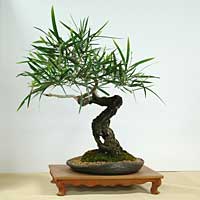 |
Backhousia myrtifolia
Grey Myrtle
This tree was purchased as a collected bonsai stock plant. When it was transferred from the original pot to a training pot one extended root was cut off and the cut off end, with roots, was planted to make a smaller bonsai. The myrtle has been in training for 2 years and has developed very well in that time. It is a rewarding native to work with as the leaves are very attractive and nicely in proportion with the plant.
photo: MF.1457 Catalogue No. 2 |
 |
Banksia integrifolia
Coastal Banksia
This banksia was purchased for $4 from a throw out bin at a nursery. The pot could not be put on the ground because the tree was ‘cascading’ and customers were looking for upright garden plants. It has been in training for 4 years. In 2004 the banksia came second at the Royal Easter Show in Sydney. At the 2005 Royal it was judged 1st in both Native and Champion Native in Show. The tree has been recently root pruned and repotted and the bonsai artist is still looking for a more suitable pot.
photo: MF.1456 Catalogue No. 1
|
 |
Banksia integrifolia
Coastal Banksias
photo: MF.1487 Catalogue No. 30 |
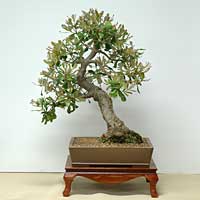 |
Banksia marginata
Silver Banksia
This tree is modelled on a Banksia growing in a garden near the cliff tops at Avalon, NSW. I was struck by its heavy lowest branch sweeping down to the ground then growing upwards at the tip. I often wondered if children playing had helped shape that tree. I have found this particular tree, at least as a young plant, does not like having its branches wired strongly down unless the tip is allowed to grow up strongly. Specimens I have grown on in the garden as bonsai material developed a mixture of upward and downward growing branches, so perhaps the garden inspiration was a natural shape after all.
photo: MF.1482 Catalogue No. 25 |
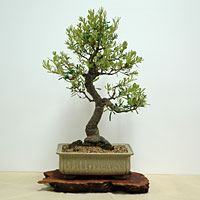 |
Banksia marginata ‘Mini Marg’
Dwarf Silver Banksia
This cultivar came on the market in the early ‘naughts’. It to hail from the northeast coast of Tasmania, and is somewhat drought tolerant. The plant here is a young bonsai – determining how to prune it to achieve branch development is still a challenge. It is presented here in a special pot that evokes a cliff-edge habitat in twilight, where the sandstone cliffs still glow ruddy while the depths below them are swathed in the blue-black of evening. The miniature tree, growing on the cliff-edge, hugs the ground.
photo: MF.1485 Catalogue No. 28 |
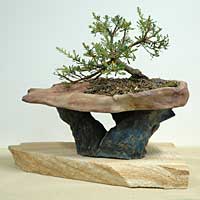 |
Banksia serrata
Saw Banksia
Soon after purchasing, this tree was cut back hard and has since been developed by a combination of wiring and clip and grow.
photo: MF.1464 Catalogue No. 9 |
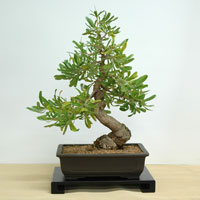 |
Banksia serrata
Saw Banksia
Banksia serrata grows as a shrub to small tree with corky bark.
The bonsai displayed here is believed to have been started from seed in 1982. I acquired the tree from a fellow bonsai enthusiast in a rather bushy and very pot bound state in 1999. As the tree was still in its original plastic nursery pot, full to the brim with roots, there was a lot of work to be done on the tree to start creating anything resembling a bonsai.
I was attracted to the wrinkled (“old man”) trunk of the tree initially, but it had also flowered beautifully shortly after I got it. It has been potted in a variety of pots since I got it. The current one is Australian made from Mirkwood.
photo: MF.1474 Catalogue No. 18 |
 |
Banksia serrata
Saw Banksia
I bought this tree as small nursery stock during a visit to family in Melbourne for Christmas 1984. It was left in the care of my mother-in-law until we returned two years later. It had grown well and was too tall to fit in the car, so I cut the top section off and sealed it with some gum my son was chewing. My mother-in-law was quite shocked to see how I treated the plant she had tended so carefully. A few years later I very nearly cut it back just above the first branch to create a more interesting trunk line. The tree was a lot thinner then and this would have worked quite well in conjunction with changing the planting angle. I was persuaded to leave it, but have since grown the branches out to make a better mature tree form.
photo: MF.1481 Catalogue No. 24 |
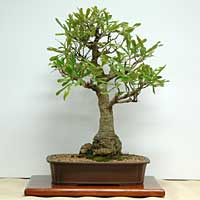 |
Callistemon viminalis
Bottlebrush
This bottlebrush was average garden centre material in April of this year. It was bought for the purpose of demonstrating what kind of bonsai styling can be achieved with just a sample of our native Australian garden shrubs. Since this is the “Weeping” bottlebrush, it was decided that the branches should be directed downwards from the start, and to accommodate the tree a cascade pot therefore seemed appropriate. Since its styling and planting 7 months ago, this small tree has flourished. It receives full sun for the major part of the day and is demanding in only one respect: it needs lots of water!
photo: MF.1470 Catalogue No. 15 |
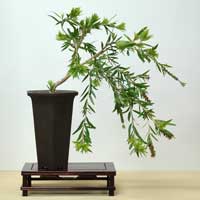 |
Callistemon sp.
Bottlebrush
The ‘Lizard’s Lair’ is the hide away in the hollow of a bottle brush tree for my “Serpents”. The tree was dug by Mick Balzary 15 years previously from Wee Jasper. I bought the stock plant at the Wagga Wagga AABC Seminar in 2001. It has undergone massive alteration, especially concentrating on the central split. Only now, I feel; it is beginning to become a presentable bonsai.
Dorothy Koreshoff
photo: MF.1476 Catalogue No. 20 |
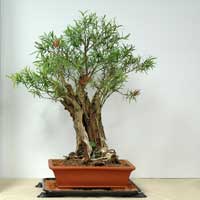 |
Callitris glaucophylla
This tree was dug from my father in-law’s property in West Wyalong in approx. 1997. This was my first cypress pine and I was unsure how it would react to bonsai techniques. It was a gradual process over 3 years to reduce the root ball size so as it could be potted into a bonsai pot, which was done in 2000. The trees I have seen in the paddocks of western NSW inspirde the shape of this tree, although I have been unable to reproduce the incredible twists and turns of the branching. The current pot is Australian made by Pat Kennedy.
photo: MF.1467 Catalogue No. 12 |
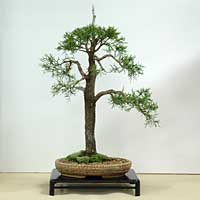 |
Callitris glaucophylla
White Cypress Pine
This Callitris glaucophylla was collected during a dig following the Australian Associated Bonsai Club National Seminar held in Wagga Wagga, New South Wales in 1999. The tree was grown on in a large pot. Continual pinching back of new growth has kept the foliage to a rounded shape. In 2004 the tree was potted in to a bonsai pot and the lower branches have been wired to spread the foliage.
photo: MF.1486 Catalogue No. 29 |
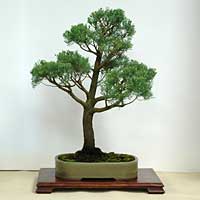 |
Callitris sp.
Cypress Pine
Grown from a cutting salvaged from the floor at a workshop in 1990. Grown on in the ground and training pot until styled and planted in a bonsai pot in 1996. Styling is difficult because in does not hold it’s shape when wiring is removed. The main method of shaping the tree has been finger tip- pruning
photo: MF.1466 Catalogue No. 11 |
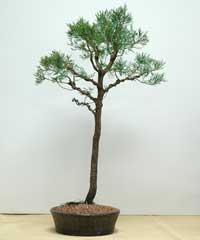 |
Elaeocarpus reticulatus
Blue Berry Ash
The blueberry ash is a medium tree to 15 m. It has lanceolate, toothed leaves, pink or white flowers, and blue berries, hence the common name.
The setting on display is referred to as ‘billabong’. The tree was purchased from Cambewarra Nursery 6-7 years ago. They acquired it from a bush dig. I kept it in a growing pot for 12-18 months before I could decide what to do with it. Then one day I saw a billabong in the arrangement of the trunks. The original tree, in the centre, has died and rotted away, leaving the suckers (trunks). The leaves reduce when defoliated. When they get old, they turn bright yellow and dark red.
photo: MF.1469 Catalogue No. 14 |
 |
Eucalyptus meliodora
Yellow Box
In training for 18 years, this tree has gone through crises not unlike those that afflict trees in nature. Here, drought killed the main trunk, stimulating regrowth from the lignotuber. The unkempt look of the crown and branches is reminiscent of a tree growing in a challenging environment. The stoniness of the ground shows through, despite the green flush from spring rains. The raw awkwardness of the pot echoes the sense of a difficult habitat.
photo: MF.1484 Catalogue No. 27 |
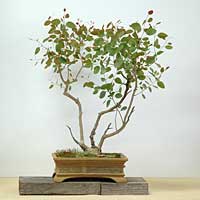 |
Eucalyptus nicholii
The tree was found at south Canberra dump in the Revolve section in the summer of 1995. It was in very little soil and full of disease (mealy bug and sooty mildew). Over the following months I removed the pests, re-potted, cut back and trained a new leader. It was kept as an experiment, I was unsure how a eucalypt would react to bonsai techniques.
In 1999 I potted it into a bonsai pot and continued shaping into a gum tree style. After the 2001 show I carved the lower and mid sections of the tree and then re-potted it. Since then I have repotted twice and it is now in an Australian pot made by Pat Kennedy.
photo: MF.1468 Catalogue No. 13 |
 |
Ficus macrophylla
This is an example of what is probably the native plant species most frequently grown as bonsai.
photo: MF.1463 Catalogue No. 8 |
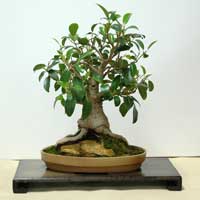 |
Ficus rubiginosa ‘Little Ruby’
This was one of the ‘original’ cuttings of the first “Little Ruby”, discovered as a seedling in 1987, by Noel Summerell. I got the tree from Grant Bowie. Noel was not able to get any to strike as cuttings until 1990 when he removed branches with a bit of aerial roots running down the side of the trunk and into the ground. These struck easily and were the first eight original cuttings. The one on display is one of these eight. It's a beaut little tree, though only a small one.
photo: MF.1475 Catalogue No. 19 |
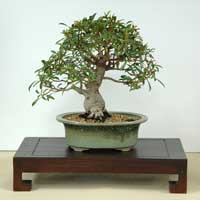 |
Grevillea ‘Scarlet Sprite’
I have really enjoyed this little tree. I used it as demonstration material for the second Australian Plants as Bonsai show in 2004. It was really easy to choose the lines I wanted to keep and I am very happy with the way it has developed. It responds well to trimming and has flowered for much of winter and spring in 2005. The pot was made by a local amateur potter about 20 years ago and works well with many Australian plants.
photo: MF.1483 Catalogue No. 26 |
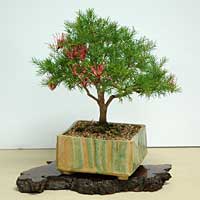 |
Kunzea ambigua
‘The Escapee’
I have an attraction to odd trees and snatched this very immature kunzea from a bonsai nursery . Initially the nicely contorted thin trunk was supported with a wine cork but now it cantilevers on its own power. I wanted the impression of growing in a crevice and Pat Kennedy of Mirkwood Forest created a rugged pot. The kunzea is very easy to look after and while its style is not to everyone’s taste, it’s one of my favourite bonsai.
photo: MF.1458 Catalogue No. 3 |
 |
Largarostrobus franklinii
Huon Pine
This native species is only found in west and southwest Tasmania, next to rivers and in boggy areas. The timber was used for boat building as it did not rot and was not attacked by marine organisms. It grows very slowly, and one old tree is known to be over 4000 years old!
My original tree was purchased over 20 years ago, but this tree is a cutting, taken about 12 years ago. The stems naturally droop when young, but will eventually straighten up as they mature. The side branches often dominate, challenging bonsai styling.
It cannot be trained until the main trunk changes from green to brown. The green stems will die if wired. It will readily withstand repotting and root pruning at any time during the winter months. During the hot dry conditions, the whole pot can be stood in water for up to a week, without adverse effects. It can also endure very shady conditions but can withstand full sun, if it has enough water.
photo: MF.1472 Catalogue No. 16 |
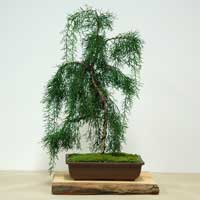 |
Leptospermum grandiflorum
The naturally zigzag growth of the branches of this plant lends it readily to bonsai aesthetics. The soft papery bark has all the character we associate with ‘paperbark’ melaleucas. The setting is severe; recalling dry rocky ground, yet the richness of the leafy canopy and the shade it casts are welcome sights to any bush walker.
photo: MF.1465 Catalogue No. 10 |
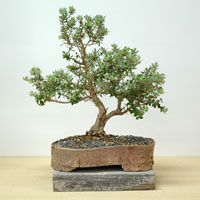 |
Leptospermum laevigatum
Coastal Tea Tree
The coastal tea tree grows on the exposed windswept sand dunes of southern NSW and Victoria. Its environment creates wonderful gnarled, twisted trunks and branches. This bonsai has been grown from nursery stock for the past eight years. I like to style my native bonsai in a “natural” style (by not slavishly following the traditional Japanese guidelines, but allowing the tree itself to dictate the direction). I consider that I have achieved an acceptable “natural” style of bonsai with this Coastal Tea Tree.
photo: MF.1479 Catalogue No. 22 |
 |
Leptospermum laevigatum
Coastal Tea Tree
This is a tree I have only been growing for a short period. Purchased as a small plant and potted on each year. I really like the blue foliage and red new growth. It was potted for the first time in a bonsai pot in September 2005.
photo: MF.1462 Catalogue No. 7 |
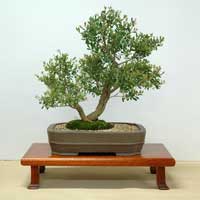 |
Melaleuca alternifolia
This tree came neglected from an enthusiast with too many trees. I fell in love with the trunk texture and the movement of the tree and set to turn the spindly, foliage-tipped branches into a more compact tree. After the initial root prune the tree was tied in the pot for stability. It stood in a water tray and in a month was rock solid in the pot and growing like a weed. With constant tip pruning and some judicious wiring the foliage thickened and the tree developed well. I have a special fondness for melaleucas because of this tree. A bit of red gravel brings out the warm rusty tones in the trunk.
photo: MF.1459 Catalogue No. 4 |
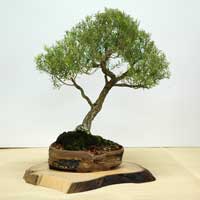 |
Melaleuca bracteata
This Melaleuca was bought from a bonsai nursery in 1997 and has been repotted four times since. It was not until 2002, when the pot was permanently placed in a deep tray with water, that it really started to grow well. Three times a year it receives a good dose of liquid organic fertiliser added to the water. Pruning back its terminal growth, and occasional thinning out, needs to be done quite regularly. One needs to watch out for red spider mite in hot weather. The lowest branches inevitably die off with time, but the process was certainly slowed down once it grew in water and was pruned regularly.
photo: MF.1461 Catalogue No. 6 |
 |
Melaleuca irbyana
This tree was purchased from a section of neglected plants in a rural nursery. It was lying on its side with a large carrot-like root protruding 15 cm from the drainage hole. The paperbark, the curve of the trunk and the feathery foliage were too interesting to pass by. There was another carrot-root in the pot and very few feeder roots. It was root pruned and repotted in late April and set in a water tray. It took 6 months for anything to develop but once it started it powered on. A weeping style is not easy because the branches want to grow UP. It requires constant wiring to keep the image and wiring is not easy because I am always running foul of the other weeping branches. But the tree has a charm and grace so I persevere.
photo: MF.1460 Catalogue No. 5 |
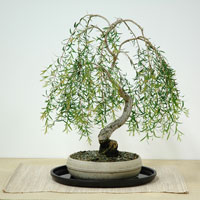 |
Podocarpus elatus
This variety has had standard bonsai treatment and has grown without problems. It requires regular watering but is not too demanding when established.
As a rainforest tree, the style would be one of the upright ones, but around Sydney, Street plantings produce informal spreading forms, the foliage assuming soft-looking billowing cloud forms. My bonsai’s style suggests that the tree has regrown after being broken in a storm – the deadwood caused by the original event rather than by continued harsh weather as is seen in Japanese bonsai and explaining the existence together, of lush foliage and dead wood!
photo: MF.1480 Catalogue No. 23 |
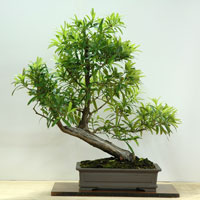 |
Zieria prostrata
Zieria prostrata grows naturally in mostly near coastal habitats in NSW. This plant was purchased from the Bonsai South Nursery in August 2004. Since then it was kept in a semi-sheltered position to acclimatise to the local weather conditions. The first styling was done in early August 2005.
photo: MF.1473 Catalogue No. 17 |
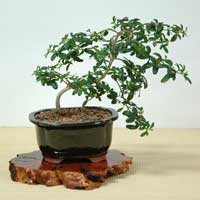 |
![An Australian Government Initiative [logo]](/images/austgovt_brown_90px.gif)


![An Australian Government Initiative [logo]](/images/austgovt_brown_90px.gif)

